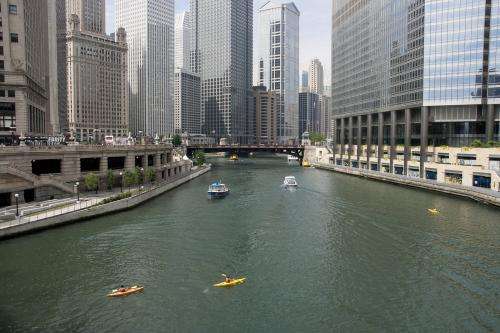Kayakers and boats traverse the branch of the Chicago River in the downtown area. Every river contains a population of microbes; scientists at Argonne are partnering with the Metropolitan Water Reclamation District to map how the River’s inhabitants change over the months and years.
Scientists from the U.S. Department of Energy's Argonne National Laboratory are partnering with the Metropolitan Water Reclamation District of Greater Chicago (MWRD) to find out the typical sources and distribution of microbial communities in Chicago-area waterways.
For the MWRD-sponsored project, Argonne scientists will analyze samples taken monthly from the Chicago River during the recreational season – between March and November – and run them through a DNA sequencer to identify and count the microbes in the river.
The entire study will take seven years and will record the changes that happen as the MWRD takes steps to manage its outflow. The samples taken this year and next will serve as a baseline, and more will be collected again each year until 2019. It will record changes in microbial communities as the MWRD begins disinfecting its secondary treated water at the O'Brien and Calumet Water Reclamation Plants and as parts of the Tunnel and Reservoir Plan – the Thornton reservoir and the first phase of the McCook reservoir are completed.
"Repeating the sampling is critical because the river's inhabitants change frequently," said Argonne environmental scientist Cristina Negri. "The microbial load changes with the season, after rainfall, during temperature swings, after large discharges, or after sewer overflows. Even boats churn up the sediments as they pass and redistribute the microbes."
"This work will provide a more genomic science-based understanding of the microbial health of the Chicago area waterways, and should help us understand the sources of microbes that we currently recognize during fecal indicator bacteria monitoring," said Geeta K. Rijal, MWRD Supervising Environmental Microbiologist.
Negri and her colleagues will create a hydrological model of the river that incorporates the microbial data, laying out how water flows from different sources and how rain events affect bacterial diversity and count.
"The river has become substantially cleaner over the past several decades, thanks to many interventions, but we still don't have a very thorough understanding of what lives there," said Dr. Jack Gilbert, an Argonne environmental microbiologist. "The EPA does require analyzing the water, but they currently just look for E. coli or a few other known pathogens. We look at all bacteria and viruses, pathogenic or not, by sequencing the genomes of the whole community and using our computational might to sort through who is there and what they are doing.
"This is important because all these species interact with one another in the water – perhaps there's another microbe or condition that triggers blooms of bad bacteria."
The team will also study how microbes flourish in specific areas and determine if, say, increasing the amount of concrete near an outflow affects bacteria, or if water quality changes as the river goes past farms or factories.
"We studied the Tongue River in Montana and found that we could detect even a tiny community of humans, just 100 people, by how the bacteria changed downstream," Gilbert said.
Provided by Argonne National Laboratory























